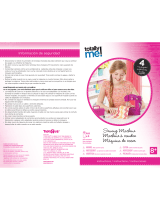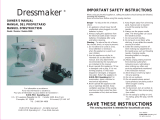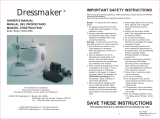
1
TABLE DES MATIÈRES
PARTIE 1. IDENTIFICATION DES PIÉCES
Identification des pièces ......................................... 3
Accessoires standard ............................................. 5
PARTIE 2. PRÉPAREZ-VOUS À COUDRE
Branchez la machine ............................................. 5
Pédale de interrupteur ........................................... 5
Caiise d’accessoires .............................................. 7
Relève-pied presseur ............................................. 7
Bouton de marche arrière ...................................... 7
Bobinage d’une canette de fil ................................. 9
Introduction de la canette .................................... 13
Enfilage de la machine ......................................... 15
Comment faire monter le fil de la canette ............ 17
Changer l’aiguille ................................................. 19
Choisir les aigilles et les fils ................................. 19
Réglage de la tension du fil de l’aiguille ............... 21
Sélecteur de point ................................................ 23
PARTIE 3. COUTURE
Point droit ............................................................. 25
Pour coudre un angle droit ................................... 27
Zig-zag simple ...................................................... 27
Surfilage avec le zig-zag ...................................... 27
Point pour jersey .................................................. 29
Feston .................................................................. 29
PARTIE 4. ENTRETIEN DE VOTRE MACHINE
Nettoyage du porte-canette ................................. 31
En cas de problème ............................................. 34
SECTION 1. NAMES OF PARTS
Names of Parts ...................................................... 2
Standard Accessories ............................................ 4
SECTION 2. GETTING READY TO SEW
Connecting Machine to Power Supply ................... 4
Foot Switch ............................................................ 4
Accessory drawer................................................... 6
Presser Foot Lifter ................................................. 6
Reverse Stitch Control ........................................... 6
Bobbin Winding ...................................................... 8
Inserting the bobbin ............................................. 12
Threading the Machine ........................................ 14
Drawing up Bobbin Thread .................................. 16
Changing Needle ................................................. 18
Selecting Needle and Thread............................... 18
Adjusting the Needle Thread Tension .................. 20
Stitch Selector ...................................................... 22
SECTION 3. SEWING
Straight Stitch ....................................................... 24
Turning a Square Corner ..................................... 26
Basic Zigzag......................................................... 26
Overcasting with zigzag stitch .............................. 26
Tricot Stitch .......................................................... 28
Scallop Stitch ....................................................... 28
SECTION 4. CARE OF YOUR MACHINE
Cleaning the Bobbin Holder ................................. 30
Troubleshooting ................................................... 32
TABLE OF CONTENTS
SECCION 1. NOMBRE DE LAS PARTES
Nombre de las partes ............................................. 3
Accessorios estándares ......................................... 5
SECCION 2. PREPARACION PARA COSER
Conexión de la máquina a la red eléctrica ............. 5
Pedal de intrruptor ................................................. 5
Caja de accesorios ................................................ 7
Palanca de elevación del prensatelas ................... 7
Control de puntada reversa ................................... 7
Embobinado de la canilla ....................................... 9
Introducción de la bobina .................................... 13
Enhebrado del hilo de la aguja ............................ 15
Extracción del hilo de la canilla ............................ 17
Cómo y cuándo cambiar la aguja ........................ 19
Seleccionar las agujas y los hilos ........................ 19
Ajuste de la tensión del hilo de la aguja ............... 21
Selector de patrón ................................................ 23
SECCION 3. COSTURA
Puntada recta ....................................................... 25
Cómo coser una esquina cuadrada ..................... 27
Puntada de zig-zag .............................................. 27
Sobrehilado con la puntada de zig-zag ................ 27
Puntada de tricot .................................................. 29
Puntada de festón ................................................ 29
SECCION 4.
MANTENIMIENTO DEL LA MAQUINA
Limpiando el portacanillas ................................... 31
Identificación y resolución de problemas ............. 33
INDICE






















